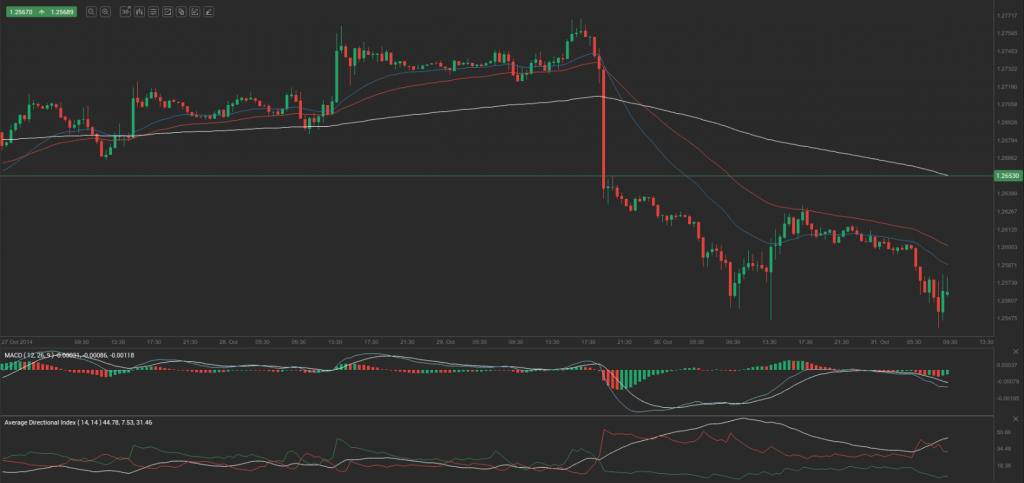Yesterday’s trade saw EUR/USD within the range of 1.2546-1.2640. The pair closed at 1.2613, losing 0.15% on a daily basis.
At 8:01 GMT today EUR/USD was down 0.36% for the day to trade at 1.2567. The pair broke the first key daily and the first key weekly support levels and touched a daily low at 1.2541 at 7:27 GMT.
Fundamentals
Euro zone
Italian unemployment
The rate of unemployment in Italy probably increased to 12.4% in September, according to the median estimate by experts, from 12.3% in the prior month. The number of unemployed persons dropped 2.6% in August compared to July to reach 3.134 million. At the same time, unemployment among persons aged 15-24 surged to 44.2% during the month from a revised 43.2% in July. In August there were 22.380 million persons in employment in Italy, or 0.1% more compared to July, as 32 000 new job positions were added. In case the rate of unemployment rose more than projected, this might have a bearish impact on the common currency. Istat is to report the official rate at 9:00 GMT.
Italian consumer inflation – preliminary estimate
Italys preliminary annualized index of consumer prices (CPI) probably remained at -0.2% in October, matching the final CPI for September, reported on October 14th. If so, this would be the lowest inflation rate in 55 years and the third consecutive month of negative inflation. Prices of non-regulated energy products dropped the most in September, by 2.8%, following a 1.2% decrease in August, while prices of services related to recreation, including repair and personal care fell 0.3% last month, after a 0.7% increase in August. Cost of unprocessed food dropped at a rate of 0.9% in September, following a sharper drop, by 1.8%, in the prior month.
Key categories, included in Italys Consumer Price Index, are food and non-alcoholic beverages (accounting for 16% of total weight), transport (15%), restaurants and hotels (11%) and housing, water, electricity and other fuels (10%). Other categories are clothing and footwear (9%), furnishing and household equipment (8%), recreation and culture (8%) and health (also 8%). Communication, education, alcoholic beverages, tobacco and other goods and services comprise the remaining 15% of the index.
Nations preliminary annualized CPI, evaluated in accordance with the harmonized methodology, probably remained at -0.1% in October, matching the final HICP estimate in September, which was released on October 14th. The National Institute of Statistics (Istat) is to release the official CPI report at 9:00 GMT.
Euro zone consumer inflation – preliminary estimate
The annualized preliminary consumer price index in the Euro zone, evaluated in accordance with Eurostat’s harmonized methodology, probably increased to 0.4% in October, according to the median forecast by experts. In September annualized consumer inflation was reported at 0.3%, or the lowest level since October 2009. The largest upward pressures to Euro Area annual inflation came from restaurants and cafés (+0.09%), rents (+0.07%) and maintenance of vehicles (+0.05%), while the largest downward pressures were caused by fuels for transport (-0.21%), telecommunications (-0.12%) and gas (-0.08%).
The index shows the change in price levels of a basket of goods and services from consumer’s perspective and also reflects purchasing trends. The main components of the HICP are food, alcohol and tobacco (accounting for 19% of the total weight), energy (11%), non-energy industrial goods (29%) and services (41%).
The HICP is used to evaluate and compare inflation rates between Member States, according to Art. 121 of the Amsterdam’s Agreement and directives by the European Central Bank (ECB), in order the latter to achieve price stability and the implementation of monetary policy. The HICP aggregates are calculated as a weighted average of each member state’s HICP components.
In case the HICP accelerated more than anticipated, thus, approaching the 2% inflation objective set by the ECB, this would certainly support demand for the euro.
The annualized preliminary Core HICP for October probably matched the final Core HICP for September, reported at 0.8% on October 16th. In August annualized core inflation was reported at 0.9%. This index excludes volatile categories such as food, energy, alcohol and tobacco. Eurostat is scheduled to release the official inflation data at 10:00 GMT.
Euro zone unemployment
At the same hour, Eurostat will announce the rate of unemployment in the Euro region for September. It probably remained steady at 11.5%, or matching the rate in June, July and August and also being the lowest since September 2012. The EU 28 unemployment rate was reported at 10.1% in August, which has been the lowest level since February 2012. According to data by Eurostat, 24.642 million people in the EU28, of whom 18.326 million were in the Euro area, were unemployed in August. Compared to July the number of people unemployed dropped by 134 000 in the European Union and by 137 000 in the Euro zone. Compared with August 2013 unemployment was lower in the EU28 (a decrease by 1.745 million), while unemployed people in the Euro area were 834 000 less.
Unemployed are considered to be all persons aged between 15 and 74, who have not been hired during the survey period, have been actively seeking employment during the past four weeks and are able to accept any job proposition right away or in two weeks time. A drop in unemployment in the region would support the single currency.
United States
Personal Income and Personal Spending
Personal spending in the United States probably rose 0.1% in September compared to a month ago, according to market expectations, while personal income was probably up 0.3%. Spending increased 0.5% in August, following a flat performance in July, while personal income rose 0.3%. Disposable personal income (DPI) increased $35.2 billion, or 0.3%, in August. Private wages and salaries rose $30.4 billion in August, compared to an increase by $17.4 billion in the prior month. Higher than expected rates of increase imply good employment conditions and, therefore, are dollar positive. The Bureau of Economic Analysis is to publish the official figures at 12:30 GMT.
Employment Cost Index
Employment Cost Index (ECI) in the United States probably rose 0.5% during the third quarter of the year compared to Q2, following another 0.7% gain in Q2 compared to Q1. The latter has been the fastest rate of increase in employment costs since Q2 2011. This index measures the change in the price of labor, defined as compensation per employee hour worked. It shows changes in the cost of compensation not only for wages and salaries, but also for an extensive list of benefits. The ECI is considered as an indicator, reflecting cost pressures within companies that could trigger price inflation for finished goods and services. A larger than expected rate of increase would generally provide a certain support to the US dollar. The Bureau of Labour Statistics is to release the quarterly data at 12:30 GMT.
Chicago Business Survey
The Chicago Purchasing Managers Index (PMI) probably slowed down to a reading of 60.0 in October from 60.5 during the prior month. If so, this would be the lowest index reading since July. The index reflects business conditions in the regions manufacturing sector and is interrelated with the Manufacturing Index, published by the Institute for Supply Management (ISM). A reading above the key level of 50.0 is indicative of expansion in manufacturing activity. In case the PMI came below expectations, this would reduce the appeal of the US dollar. The MNI Deutche Börse Group will release the official reading of the Chicago barometer at 13:45 GMT.
Reuters/Michigan Confidence Indicator – final estimate
The monthly survey by Thomson Reuters and the University of Michigan may show that consumer confidence in the United States improved in October. The final reading of the corresponding index probably confirmed the preliminary value of 86.4 during the current month, which was reported on October 17th. If confirmed, this would be the highest reading in seven years. The survey encompasses about 500 respondents throughout the country. The index is comprised by two major components, a gauge of current conditions and a gauge of expectations. The current conditions index is based on the answers to two standard questions, while the index of expectations is based on three standard questions. All five questions have an equal weight in determining the value of the overall index.
The sub-index of current economic conditions was reported at 98.9 in October, unchanged from September, while the sub-index of consumer expectations came in at a reading of 78.4 in October, improving from 75.4 in September, according to preliminary data.
In case the gauge of consumer sentiment came in line with expectations or even showed a larger improvement than projected, this would boost demand for the greenback. The official reading is due out at 13:55 GMT.
Pivot Points
According to Binary Tribune’s daily analysis, the central pivot point for the pair is at 1.2600. In case EUR/USD manages to breach the first resistance level at 1.2653, it will probably continue up to test 1.2694. In case the second key resistance is broken, the pair will probably attempt to advance to 1.2747.
If EUR/USD manages to breach the first key support at 1.2559, it will probably continue to slide and test 1.2506. With this second key support broken, the movement to the downside will probably continue to 1.2465.
The mid-Pivot levels for today are as follows: M1 – 1.2486, M2 – 1.2533, M3 – 1.2580, M4 – 1.2627, M5 – 1.2674, M6 – 1.2721.
In weekly terms, the central pivot point is at 1.2707. The three key resistance levels are as follows: R1 – 1.2803, R2 – 1.2934, R3 – 1.3030. The three key support levels are: S1 – 1.2576, S2 – 1.2480, S3 – 1.2349.






